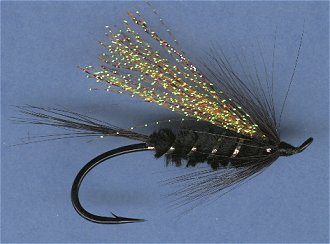
On The Fly
"Fly tying is a school from which we never graduate"
TYING NEWS
The Southern Oregon Fly Tiers met Tuesday, August 14th, at the Madrone Hill community building near Gold Hill. The location is working out great, there’s plenty of room for more tiers. We encourage novice and experienced tiers alike to drop by the second Tuesday of each month for a fun evening. The next meeting will be on Tuesday, Sept. 11th. Our members have been asked by “Casting for Recovery” for fly donations. We are each working hard to donate a dozen to this worthy cause. I encourage every tier to do the same.
 PATTERN OF THE MONTH - Tiger Paw
PATTERN OF THE MONTH - Tiger Paw
Hook: Standard salmon/steelhead size 2-8.
Thread: 6/0 black.
Tag &Rib: Oval copper tinsel.
Tail: Black hackle barbs.
Body: Black chenille.
Wing: Copper Crystal Flash.
Collar: Black hackle
Tying Instructions:
1) Start the thread 2 eye-widths back and wrap the thread to a point
just above the hook point.
2) Tie in the oval copper tinsel and wrap it forward 3 tight turns to
form the tag. Do not trim the tinsel as it will be used for the rib.
3) Tie in a small bunch of black hackle barbs on top of the hook at the
base of the tinsel for a slightly cocked tail. The barbs should extend
past the bend of the hook.
4) Tie in the black chenille and wind it forward to the front thread
marker. Tie it off and trim it.
5) Counter-wind the tinsel forward in 5 even turns through the chenille.
Tie it off and trim it.
6) Select about 20 strands of the copper Crystal Flash and tie in at the
front of the body. This should cock the flash at the proper 45 degree
angle. Trim the flash even with the hook bend.
7) Select a black hackle long enough to reach the hook point, tie it in
by the tip, take 3 turns to form the hackle collar, and then tie off the
hackle.
8) Form a neat tapered head, whip finish and apply cement.
This popular Rogue River Steelhead pattern was actually developed for the Umpqua River in the 1980’s by Joe Howel. Since that time it has also become an effective producer on the Dechutes and in British Columbia. Smaller sizes seem to work best on our home water for summers and half-pounders.
TYING TIPS
This is a fairly easy tie using common materials, but
proportions are essential for success. Pay close attention to the length
of each component as it is tied on and trimmed. Note that the wing is
tied behind the collar hackle. You can achieve the proper angle by
attaching it very close to the chenille tie-in point. If you need a
steeper angle take a couple thread turns behind the wing material for
extra support. Orange Crystal Flash can be substituted for copper color.
Vary the size for the area and conditions. So tie some up, give them a
test flight, and let me know how you did.
Tie One On,
Dan Kellogg (you can contact me at FLYGUY@EZNORTHWEST.COM)